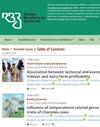猪场整合系统环境控制的社会经济和投资概况
IF 1.2
4区 农林科学
Q3 Agricultural and Biological Sciences
Revista Brasileira De Zootecnia-Brazilian Journal of Animal Science
Pub Date : 2022-01-01
DOI:10.37496/rbz5120210106
引用次数: 1
摘要
-本研究的目的是描述和了解猪场气候控制和自动化技术的投资概况,重点关注同一集成系统的综合生产者。190个综合生产商回答了一份结构化问卷,包括开放式、二选法或多项选择题,这些生产商被划分为苗圃(28,300头猪)、断奶至育肥猪(WTF);144,388头猪),或精加工单位(FU;164,185头猪)农场。根据综合生产者的类型(苗圃、WTF和FU)和24个月的收入历史对数据进行描述和分类。最主要的农民特征是44.5岁的男性,中等教育程度不高。以家庭劳动力为主的农场居多,平均面积为43.6±65.5 ha,有经济活动约2.4个。总的来说,观察到劳动力可用性减少,尽管综合生产者宣布对这些活动感到满意。有趣的是,拥有较好收入历史的整合生产商的工作时间更长(高= 37;平均= 31;Regular = 31;低= 28分钟)。自动化技术的投资概况是保守的;然而,猪生产性能的潜在改善是潜在投资最普遍的理由。此外,高成本、技术知识、利率和可用材料的质量是投资于环境控制的限制因素。74%的综合生产商认为该活动具有经济效益。最后,采用环境控制技术与农民的平均收入密切相关。本文章由计算机程序翻译,如有差异,请以英文原文为准。
Socioeconomic and investment profile of environment control in a swine integration system
- The objective of this study was to characterize and understand the investment profile towards technologies for control and automation of climate control on swine farms, focused on integrated producers on the same integration system. A structured questionnaire including open, dichotomic, or multiple-choice questions was responded by 190 integrated producers classified as nursery (28,300 swines), wean-to-finish (WTF; 144,388 swines), or finishing unit (FU; 164,185 swines) farms. Data were described and categorized according to the type of integrated producer (nursery, WTF, and FU) and income history during a 24-month interval. The most predominant farmer profile was of a 44.5-year-old man, with incomplete secondary education. Furthermore, the majority of the farms had family-based labor with an average area of 43.6±65.5 ha and ~2.4 economic activities developed. Overall, a reduced labor availability was observed, although the integrated producers declared to be satisfied with the activities. Interestingly, integrated producers with a better income history declared a longer working (high = 37; average = 31; regular = 31; low = 28 min). The investment profile in automation technologies is conservative; however, potential improvements in pig performance were the most popular justification for potential investments. Furthermore, high costs, knowledge in technologies, interest rates, and quality of the available material are the limiting factors for investing in environment control. A total of 74% of the integrated producers considered the activity as economically profitable. Lastly, the uptake of environmental control technologies is strongly associated with the average income received by farmers.
求助全文
通过发布文献求助,成功后即可免费获取论文全文。
去求助
来源期刊
CiteScore
1.90
自引率
0.00%
发文量
25
审稿时长
8 weeks
期刊介绍:
The Revista Brasileira de Zootecnia (RBZ; Brazilian Journal of Animal Science) encompasses all fields of Animal Science Research. The RBZ publishes original scientific articles in the areas of Aquaculture, Biometeorology and Animal Welfare, Forage Crops and Grasslands, Animal and Forage Plants Breeding and Genetics, Animal Reproduction, Ruminant and Non-Ruminant Nutrition, and Animal Production Systems and Agribusiness.

 求助内容:
求助内容: 应助结果提醒方式:
应助结果提醒方式:


